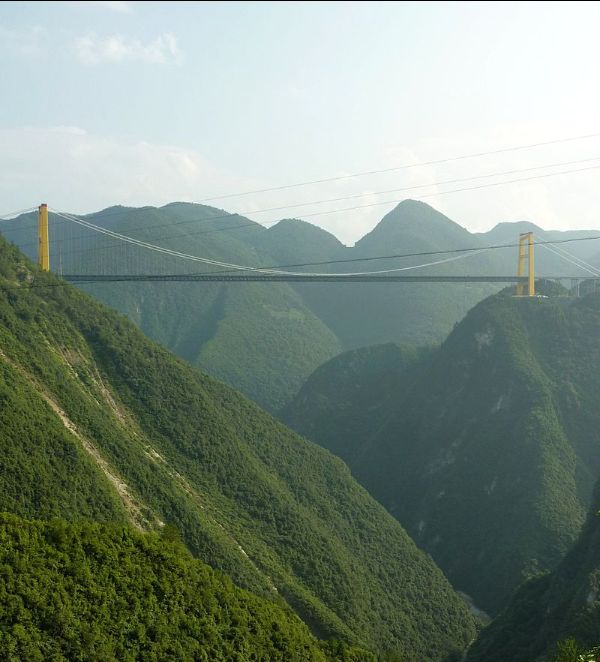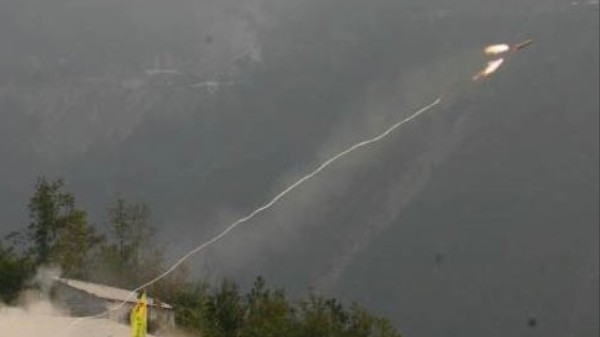A Bridge With Some Firepower
The Chinese metropolitan areas of Shanghai and Chonquin each have populations of about 30 million people, making them two of the largest in the world. And it makes sense that the Chinese government wants to connect them, but that’s easier said than done. The two cities are separated by roughly 1,200-miles (1,900 km), and while a superhighway (the G50 Shanghai–Chongqing Expressway) runs between them, it’s not just mile after mile of road. Like any other road that long, there are going to be some bridges. And one bridge, in particular, proved tricky. Take a look at the Sidu River Bridge, pictured below.

It’s big. Very big. And it’s high up. Very, very high up. From its opening in 2009 until 2016, the Sidu River Bridge was the world’s highest, at one point reaching 1,627 feet (496 meters) from the river below. It’s so tall that, as the BBC noted, “you can fit the Empire State Building beneath it — with room to spare.” The bridge runs just over 4,000 feet (1,222 meters) in length and its longest span, seen above, stretches 3,000 feet (900 meters). So as you can imagine, building it was hardly easy. To make matters worse, the terrain isn’t all that conducive to bridge-building: the river is so far down that it’s not even in the picture, the cliff faces are steep, and the canyon zigzags through the landscape. Just getting the bridge started seemed impossible.
Which is why this happened.

That image (via Vice) isn’t the clearest, so let’s walk through it a bit. The picture was taken before the bridge was built (obviously; there’s no bridge in the picture). The grey bunker in the bottom-left of the is, roughly, the location of one of the supports for the largest span. The white streak extending from the ground toward the upper-right is what’s called a “pilot cable,” the first part of the suspension cable that would keep the future bridge erect. At the untethered end of the cable is something that looks a lot like a missile. That’s because it basically is one.
Okay, more like a rocket. But it’s a military rocket, so close enough. Typically, pilot cables are strung by boat, but the height of the bridge — and the curving river path — made that untenable. The other common option was to run the pilot cable via helicopter, but that proved untenable as well. As Vice explained, “the winds that regularly rip through the valley [made] helicopter-based work dangerous.” But China wasn’t about to give up. The bridge, once opened, would connect remote areas via a relatively straight line, saving some drivers as much as nine hours off a formerly 12-hour trip.
Enter the military and their rockets. In an article for Civil Engineering Magazine (again via Vice), authors Chongxu Wang, Yuancheng Peng, and Yinbo Liu described how tools usually used to blow stuff up were instead used to build this marvel:
A special launching system using rockets attached to chinlon [a nylon-based fabric] rope pilot cables was designed. On October 9, 2006, two rockets were fired to take the two 1,300 m long ropes made of chinlon, a highly elastic yarn, over the canyon, a distance of roughly 1,100 m. The margin for error in any direction was plus or minus 40 m, and the cables landed within 10 to 15 m of their intended locations.
And unlike, say, having a boat or helicopter drag the pilot cable across, the rocket method was really, really fast — the entire trip took only about 10 seconds.
In 2016, the Sidu River Bridge became the world’s second-tallest bridge; China constructed one that spanned 1,850 feet (565 meters) over another river. But the pilot cables for that bridge were deployed by conventional methods, not conventional weapons. To date, the Sidu River Bridge remains the only bridge established by rocketry.
Bonus fact: The “China plus rivers plus ammo” combo isn’t unique to the Sidu River Bridge. In 2014, one of the Yellow River’s many curves clogged up as ice floes congregated in the bend. Surrounding areas were at risk of flooding, so the authorities needed to find a way to clear the ice. Their solution? Attack the ice — literally. As Time reported, the government “sent three bombers [ . . ] to bombard the river and break up the ice. The barrage of 24 bombs successfully smashed the ice floes, lowering the water level that had risen to dangerous levels [the day prior].”
From the Archives: How the Soviet Union Saved Vulcan: It’s not the story of Star Trek. It’s the story of a bridge.
